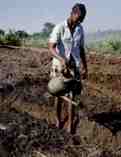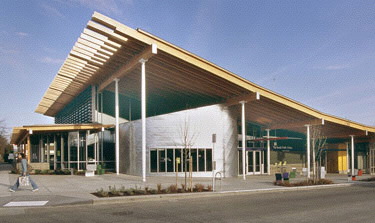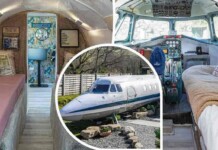 US financier George Soros is to invest $50 million in a development project that aims to show how targeted investment can end extreme poverty in African villages. His donation is being matched by other donors to bring in $100 million for The Millennium Villages program which involves small, focused investment in community-driven projects in the health, education and agriculture sectors…
US financier George Soros is to invest $50 million in a development project that aims to show how targeted investment can end extreme poverty in African villages. His donation is being matched by other donors to bring in $100 million for The Millennium Villages program which involves small, focused investment in community-driven projects in the health, education and agriculture sectors…
Soros Invests $50M to Lift African Villages From Poverty
Wetlands Funding Approved by U.S. House
The U.S. House of Representatives on Tuesday approved legislation to reauthorize the North American Wetlands Conservation Act. The bill, which was passed by lawmakers without debate, authorizes $375 million to fund wetlands conservation programs over the next five years. (ENS)
Branson Investing $400m in Eco-Friendly Fuel Research

Richard Branson went green today when his Virgin Group launched an investment fund for environmentally friendly fuels. Branson said the new Virgin Fuels business will invest up to $400m (€315.6m) in renewable energy initiatives over the next three years. The most exciting news is that Branson said…
Crafting Guns into Guitars
 Polished rosewood, guitar frets and strings are added to the shotguns and AK-47s reclaimed through Colombia’s peace process “turning tools of death into symbols of hope… As part of a United Nations program to promote peace, Luis Alberto Paredes receives the decommissioned rifles with the working parts wielded together for safety… Now, his distinctive instruments are sought by musicians worldwide.” Carlos Santana and Paul McCartney are on the long waiting list… (Sapa-AP or Reuters)
Polished rosewood, guitar frets and strings are added to the shotguns and AK-47s reclaimed through Colombia’s peace process “turning tools of death into symbols of hope… As part of a United Nations program to promote peace, Luis Alberto Paredes receives the decommissioned rifles with the working parts wielded together for safety… Now, his distinctive instruments are sought by musicians worldwide.” Carlos Santana and Paul McCartney are on the long waiting list… (Sapa-AP or Reuters)
Just-a-Minute Can Transform Your Life
 A new campaign to create personal peace in an ever-intensifying global climate of chaos and change is being launched this Sunday at London’s Wembley Arena and around the world with an internet simulcast. Entitled just-a-minute (j-a-m), the initiative introduces regular one-minute periods of silence into peoples lives, whether stressed out executives, social activists or busy moms, and includes multi-media tools such as one minute spoken meditations to download onto computers or podcast…
A new campaign to create personal peace in an ever-intensifying global climate of chaos and change is being launched this Sunday at London’s Wembley Arena and around the world with an internet simulcast. Entitled just-a-minute (j-a-m), the initiative introduces regular one-minute periods of silence into peoples lives, whether stressed out executives, social activists or busy moms, and includes multi-media tools such as one minute spoken meditations to download onto computers or podcast…
Organized by the Brahma Kumaris, a global women-led spiritual organization, the just-a-minute campaign emphasizes the positive effects of meditation on our health and well-being. Its purpose is to help people incorporate a short period of meditation into their busy schedules.
Join people around the world for a virtual one minute wave of peace this Sunday, September 17, via the Internet. Register on the just-a-minute website and your locations will light up on a vast world map visible in the Wembley stadium.
The Benefits of Meditation
Meditation is now offered in schools, hospitals, offices, government buildings and prisons to help people relax and refresh the mind making it more focussed and effective. Increasingly aware of the well documented benefits, doctors are recommending meditation for patients with chronic problems such as heart conditions, AIDS and cancer, as well as depression, hyperactivity and ADD.
- Meditation can be an active rather than passive process. Brain areas dealing with input from the senses become less active, but other parts “light up†and the heart rate increases.
- People who believe in and practice connecting with a transcendent being suffer less from symptoms of depression than those who don’t.
- Scientists used to believe connections among brain cells were fixed early in life and did not change in adulthood. But recent studies using brain imaging have shown that meditation can enhance brain circuitry. It can improves mental activity by increasing coordination between different brain areas.
The Web cast begins at 3:30pm London time, 10:30am New York time. The global link up segment starts at 4:00 pm in London (11:00am NY) with 100 countries tuning in and lighting up the world map. At 4:25pm (11:25am in New York) the one-minute of silence will commence spreading a wave of peace across the world.
The just-a-minute launch event is dedicated to the United Nations International Day of Peace (September 21) and celebrates 70 years of Brahma Kumaris World Spiritual University.
The Wembley event is free to the public but very few tickets remain. To reserve your seat, or for more information, visit www.just-a-minute.org or call 020 8902 4141 (in England).
Four Exchange Kidneys In Remarkable Swap
A new program allows healthy family members to donate their kidneys to strangers in exchange for receiving an organ for their loved one. In Chicago, the second such swap ever brought together two families from very different backgrounds and united them in a bond of lasting friendship. Instead of Doug’s wife only helping her husband, she is helping someone else in the process. Watch the video or read the story at CBS2Chicago.
Clean Up the World Weekend Mobilizes Millions
 Some 35 million volunteers from 122 countries are expected take part this weekend in rubbish-clearing efforts along coastlines and waterways across the globe as part of the annual Clean Up the World Weekend. Volunteers will pick up trash on beaches, in villages and at various other sites around the world, among them Australia’s Sydney Harbour, the Nile River in Egypt, and Rio de Janeiro’s Copacabana Beach.
Some 35 million volunteers from 122 countries are expected take part this weekend in rubbish-clearing efforts along coastlines and waterways across the globe as part of the annual Clean Up the World Weekend. Volunteers will pick up trash on beaches, in villages and at various other sites around the world, among them Australia’s Sydney Harbour, the Nile River in Egypt, and Rio de Janeiro’s Copacabana Beach.
U.S. Muslim Scholars Issue Edict Against Terrorism
I missed this at the end of July, but thanks to Columbine who submitted the link this week, we learn about Muslims who are taking sensible action… Muslim scholars from the United States and Canada have issued a "fatwa" against terrorism. While many American Muslim groups have repeatedly condemned acts of religious extremism, the new edict carries the weight of an official judicial ruling. (full story at NPR)
9-11 After the Hype: GNN Recalls the Good News of the Day
 If you are tired of reliving the fear or sadness or the calls for returning fire on that day in 2001, download a copy of our 8-page newsletter published in the weeks following 9/11. Called Some Good News! — but no longer in print — it is a great reminder of some of the positive feelings that followed the crisis. Download the PDF file here, and feel the peace.
If you are tired of reliving the fear or sadness or the calls for returning fire on that day in 2001, download a copy of our 8-page newsletter published in the weeks following 9/11. Called Some Good News! — but no longer in print — it is a great reminder of some of the positive feelings that followed the crisis. Download the PDF file here, and feel the peace.
9-11 Special: Healing the Soldiers’ Wounds
 Thousands of U.S. veterans have returned from Iraq and Afghanistan maimed and disfigured, their lives forever changed. The National Theatre Workshop of the Handicapped worked with two dozen veterans of U.S. wars in Iraq and Afghanistan this summer, in hopes of helping them work through their emotions and feelings of loss…
Thousands of U.S. veterans have returned from Iraq and Afghanistan maimed and disfigured, their lives forever changed. The National Theatre Workshop of the Handicapped worked with two dozen veterans of U.S. wars in Iraq and Afghanistan this summer, in hopes of helping them work through their emotions and feelings of loss…
Brother Rick Curry, a Jesuit, founded the theater workshop in New York nearly 30 years ago to help people with disabilities learn communication skills necessary for careers in theater and to enhance workplace opportunities.
One soldier, who joined the military after the 9-11 attacks, is determined to overcome his injuries through writing fiction with the help of the theatre company. His full story at Vermont Times Argus.
Brother Rick persevered over his own disabilities (he was born without a forearm) to dedicate his life to helping people all over the world to find their independence and creativity as he found his. Rick’s efforts include opening a bakery to offer job opportunities and teach business skills to those physically challenged, empowering others while raising funds for his theatre program.
On this Date (9-11) Gandhi’s Truth-Force Movement Born
 As we commemorate the attacks of 9/11, there is a reason to celebrate the day.
As we commemorate the attacks of 9/11, there is a reason to celebrate the day.
One hundred years ago today, on September 11, 1906, Mohandas Gandhi convened a meeting in Johannesburg, South Africa, to mobilize his community to oppose racially degrading legislation. On that September 11th, more than 3,000 people solemnly pledged to disobey the proposed law. So began the “Satyagraha” (or truth-force) movement of organized nonviolent action, and the unfolding history of people-power movements.
10 Most Innovative Biodegradable Products
 Take a look at some of the world’s most amazing biodegradable products, from baby wipes to kitchen bowls and cell phones. (EcoFriend) And, also check out the Web site’s "top 10 green accessories and gadgets that will surely turn your kitchen green," like wheat-based cutlery, instead of plastic, which is also biodegradable.
Take a look at some of the world’s most amazing biodegradable products, from baby wipes to kitchen bowls and cell phones. (EcoFriend) And, also check out the Web site’s "top 10 green accessories and gadgets that will surely turn your kitchen green," like wheat-based cutlery, instead of plastic, which is also biodegradable.
Microbes Can Clean Up Toxic Waste Dumps
Microbes found in old waste sites in Australia not only tolerate lethal soil and water cocktails created by waste petroleum and chlorine, but can break them down so they no longer threaten humans, the scientist said on Friday. (Reuters)
Rate of Deforestation in Amazon Slowing
Deforestation rates in the Amazon are declining, according to data released by the Brazilian government. Rates of deforestation from 1 August 2005 to 1 August 2006 dropped an estimated 11 percent.
Christian Group Encourages Recycling
Tending to your soul at the Vineyard Christian Fellowship in Boise, Idaho, involves recycling old cell phones and printer cartridges in the church lobby, pulling noxious weeds in the backcountry and fixing worn-out hiking trails in the mountains. This is part of the ministry of Tri Robinson, a former biology teacher whose rereading of the Bible led him to the belief that Christians focused on Scripture need to combat global warming and save the Earth. (AP)
Crimes Down by 50,000 in Scotland
Nearly 50,000 fewer crimes were committed in Scotland last year compared with the previous 12 months, down 6 percent. Violent crime fell 7 percent and crimes of indecency 10 percent, while housebreaking and other dishonesty offences dropped for the seventh year in a row.
G is for Gorgeous Albuquerque
EDITOR’S BLOG
I am in beautiful New Mexico on vacation with my family. We’re attending our fourth annual Live and Learn Unschooling Conference and the organizers couldn’t have picked a more beautiful place than the Hotel Albuquerque in Old Town… 150 families of radical unschoolers playing together, performing and living together. It is the most amazing of events.
I am leading a "Funshop" for conference participants about photography later today and only was inspired to do it this morning. So I’ll need to do some organizing of photos on my laptop before the session begins (Woman, right, selling turquoise: should have used flash)…
Paper Made From Sheep Droppings
![]() Creative Paper Wales wanted to create a product with which foreign imports could not compete. Its Sheep Poo Paper accomplished that (Wales has a lot of sheep) and also benefitted the enviroment and won the company a £20,000 Millennium Award for "social entrepreneurship…
Creative Paper Wales wanted to create a product with which foreign imports could not compete. Its Sheep Poo Paper accomplished that (Wales has a lot of sheep) and also benefitted the enviroment and won the company a £20,000 Millennium Award for "social entrepreneurship…
The Top Ten Green Buildings for 2006
 This summer, the American Institute of Architects and its Committee on the Environment selected the top ten examples of sustainable architecture and green design solutions that protect and enhance the environment. The Top Ten Green Projects make a positive contribution to their community by improving comfort for building occupants, while reducing environmental impacts through strategies such as: connection to transit systems, energy and water conservation, use of sustainable or renewable construction materials, and improvement of indoor air quality…
This summer, the American Institute of Architects and its Committee on the Environment selected the top ten examples of sustainable architecture and green design solutions that protect and enhance the environment. The Top Ten Green Projects make a positive contribution to their community by improving comfort for building occupants, while reducing environmental impacts through strategies such as: connection to transit systems, energy and water conservation, use of sustainable or renewable construction materials, and improvement of indoor air quality…
US EPA Becomes First Federal Agency to Go 100% Green
The U.S. Environmental Protection Agency (EPA) has closed a deal making it the first federal agency to purchase renewable energy, or "green power," equivalent to 100 percent of its annual electricity needs…. This green-power purchase brings the agency total to nearly 300 million kWh per year, which is equivalent to 100 percent of the electricity EPA uses in its more than 190 EPA facilities nationwide. (Sustainable Business)






















